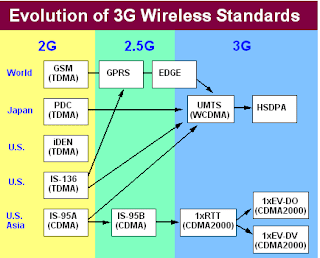First Generation Cellular Systems
The first generation cellular systems generally employ analog Frequency Modulation (FM) techniques. The Advanced Mobile Phone System (AMPS) is the most notable of the first generation systems. AMPS were developed by the Bell Telephone System. It uses FM technology for voice transmission and digital signaling for control information.
Other first generation systems include:
• Narrowband AMPS (NAMPS)
• Total Access Cellular System (TACS)
• Nordic Mobile Telephone System (NMT-900)
All the first generation cellular systems employ Frequency Division Multiple Access (FDMA) with each channel assigned to a unique frequency band within a cluster of cells.
Second Generation Cellular Systems
The rapid growth in the number of subscribers and the proliferation of many incompatible first generation systems were the main reason behind the evolution towards second generation cellular systems. Second generation systems take the advantage of compression and coding techniques associated with digital technology. All the second generation systems employ digital modulation schemes. Multiple access techniques like Time Division Multiple Access (TDMA) and Code Division Multiple Access (CDMA) are used along with FDMA in the second generation systems.
Second generation cellular systems include:
• United States Digital Cellular (USDC) standards IS-54 and IS-136
• Global System for Mobile communications (GSM)
• Pacific Digital Cellular (PDC)
•CDMA One
Third Generation Cellular Systems
In October 2001, Japan was the first country in the world to introduce 3G services to a 30km radius around Tokyo. Europe and the US are releasing GPRS systems and testing 3G technologies and strangely enough the Isle of Man is set to be the next 3G contender.
 |
| Figure-1.3 |
Why 3g
Third generation cellular systems are being designed to support wideband services like high speed Internet access, video and high quality image transmission with the same quality as the fixed networks. The primary requirements of the next generation cellular systems are:
• Voice quality comparable to Public Switched Telephone Network (PSTN).
• Support of high data rate. The following table shows the data rate requirement of the 3G systems.
• Support of both packet-switched and circuit-switched data services.
• More efficient usage of the available radio spectrum
• Support of a wide variety of mobile equipment
• Backward Compatibility with pre-existing networks and flexible introduction of new services and technology.
• An adaptive radio interface suited to the highly asymmetric nature.
• Internet communications: a much greater bandwidth for the downlink than the uplink.
Today's 2G GSM mobile phones can download 9.6kbper second. 3G technologies promise up to 2 Mbps. The technology has been on the cards for some time now but the introduction of these services has been beset by problems.
No comments:
Post a Comment